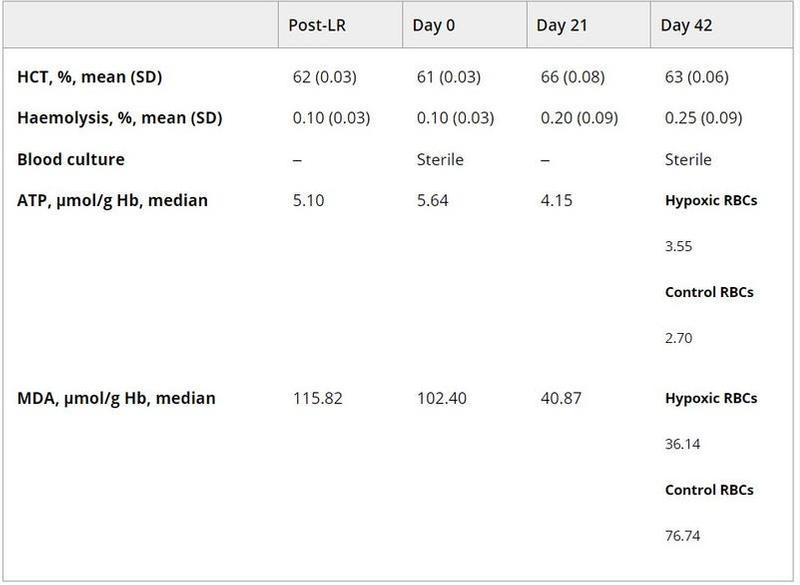The Achieving Efficiencies in Blood Component Production session included the following presentations:
1. Shanti Krishnan: Automation In Blood Product Manufacturing
2. Joanne Tan: Assessment Of Biological Response Modifiers In Cold-Stored Group O Whole Blood Product
3. Beatrice Hechler: In Vitro Biochemical And Functional Comparison Of Amotosalen-UVA-Treated Buffy-Coat Platelet Concentrates Stored In Pas-C Or Pas-E Additive Solution Up To 7 Days
4. Danny Brouard: Quality Of Red Cell Concentrates From Non-Anemic Donors With Signs Of Iron Deficiency
5. Vanessa Agostini: Preparation Of Hypoxic Red Blood Cells For Transfusion Of Thalassemia Study Patients
MODERATORS: Denese Marks, Jason Acker
After the presentation, there was a questions and answers session, which is also included in the recording.
Abstract
Preparation of hypoxic red blood cells for transfusion of thalassemia study patients
V Agostini1, L De Franceschi2, G Forni3, A Mattè4, G Grazzini5, A Dunham6, K Dorsch6, L Omert6
1Transfusion Medicine, IRCCS Ospedale Policlinico San Martino, Genoa, 2University of Verona and AOUI Verona, Verona, 3Center for Congenital Anemias, Galliera Hospital, Genoa, 4University of Verona ‘G.B. Rossi’ Hospital, Verona, Italy, 5Consultant, 6Hemanext Inc., Lexington, United States
Background: Red blood cells (RBCs) are subject to metabolic and oxidative impairments accumulating during storage. RBC deformability progressively diminishes over time, affecting microcirculation perfusion. Hypoxic storage, where the oxygen content of RBC units is reduced prior to refrigeration and throughout storage, is a viable alternative to reduce oxidative stress. In vitro, hypoxic storage reduces oxidative impairments that occur during normal storage, providing more viable cells at transfusion (Yoshida T, et al. Blood Transfus. 2019;17:27–52). Metabolomic analyses of hypoxic RBCs have shown increased ATP synthesis and a decrease in oxidative stress biomarkers (D’Alessandro A, et al. Transfus. 2020;60:786–98). In animal models, hypoxic RBCs facilitated more effective resuscitation from haemorrhagic shock than conventionally stored RBCs (Williams AT, et al. Shock. 2020;53:352–62). Hemanext Inc. (Lexington, MA, United States) has developed a CE mark certified device to process and store RBCs hypoxically–CPD/PAGGSM Leukocytes-Reduced (LR), O2/CO2 Reduced–which may reduce transfusion burden in transfusion-dependent patients and attenuate the oxidative stress associated with acute major bleeding. Ahead of a post-market clinical investigation of patients with thalassemia in Italy, a validation study of the in vitro performance of hypoxic RBCs was conducted at the Regional Blood Bank in Genoa, Italy.
Aims: To evaluate RBCs stored hypoxically for 42 days after pre-storage O2/CO2 reduction.
Methods: The study was designed so that results would be applicable throughout the Italian regional blood centres. Informed consent was obtained from all donors. Each whole blood unit collected generated one unit of O2/CO2 reduced LR-RBCs. RBC filtration was performed either on the day of collection or after storage at ambient hold for up to 24 h. All units were processed using the system and stored at 1–6°C within 24 h of collection for 42 days. Control RBC units were conventionally processed and stored. Acceptance criteria (assessed after leukoreduction (post-LR) and on days 0, 21 and 42 of storage) were haematocrit (HCT) >50%, haemolysis at day 42 <0.8% and a negative blood culture. ATP and malondialdehyde (MDA) levels were measured as key energy and lipid peroxidation/oxidative stress biomarkers.
Results: Thirty RBC units stored hypoxically were evaluated and met all acceptance criteria at day 42 (Table). At day 42, we confirmed a high ATP content in hypoxic RBCs previously described in literature (D’Alessandro A, et al. Transfus. 2020;60:786–98) and found lower MDA levels compared with control RBCs (Table).
PA35-L05 – Table 1

Summary/Conclusions: This is the first report validating hypoxic RBCs for transfusion, in preparation for a clinical study of chronically transfused patients with thalassemia. Compared with conventionally stored blood, hypoxically stored RBCs met acceptance criteria for transfusion, maintained high levels of ATP, and attenuated MDA accumulation, an indirect estimate of RBC membrane oxidation. It is expected that deoxygenation of RBCs will retain more physiological levels of key blood quality parameters vs conventionally stored RBCs.




